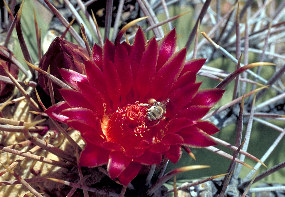Research and Conservation in Southern Sonora, Mexico
Ferocactus emoryi ssp. emoryi (Emory barrel cactus, biznaga)
The southern members of this species are massive, barrel-shaped plants to well over six feet tall and two feet in diameter. This species has only stout spines and none of the bristles common to most other Ferocactus species. These spines are short, slightly curved, and yellowish. The pure yellow flowers are borne in July.
This form occurs from about Guaymas south to *********************** in Central Gulf Coast Sonoran Desert and Coastal Thornscrub.
 Ferocactus emoryi near the coast south of Guaymas, Sonora. Note the 16-inch butcher knife. Photo: Mark Dimmitt |
Ferocactus emoryi flowers |
Ferocactus emoryi ssp. covillei (Britton & Rose) Hunt & Dimmitt
(Coville barrel cactus, biznaga)
syn. F. covillei
From about Guaymas north to southern Arizona, the plants originally described as F. covillei are very different from the more southerly F. emoryi. Juvenile plants are strongly tuberculate rather than ribbed. Mature plants are usually less than six feet tall and are more slender, cylindrical instead of barrel-shaped. The spines are heavier, longer, reddish in color, and the central is strongly curved at the tip. Lastly, the flowers are pure red. Flowers in July unless the summer rains are late. The range of this subspecies barely reaches southern Sonora.
 |
 |
| Ferocactus emoryi ssp. covillei from Ajo, AZ. The flower on the right is being visited by a cactus bee. Photos: Mark Dimmitt | |
Obvious intermediates between the two subspecies are common only along a narrow zone of contact. Near highway Mex 15 this zone is north of Guaymas, in the Sierra Libre at Cerro Las Avispas. Here most plants are more like the F. covillei form in size and shape, the spines are intermediate in size and shape, and the flowers range from yellow through shades of orange to red.
Reference: Hunt, David, & Mark Dimmitt. Entry 14356, Ferocactus emoryi ssp. covillei (Britton & Rose) Hunt & Dimmitt. in Hunt, David. 2005. Cactaceae Systematics Initiatives: Bulletin of the International Cactaceae Systematics Group 20:16. Edited & Published by David Hunt.Sherborne, England. [Basionym omitted in this publication; error corrected in issue 21:11.]



